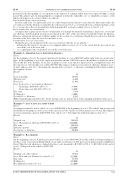Page 537 - SAIT Compendium 2016 Volume2
P. 537
IN 60 Income Tax acT: InTeRPReTaTIon noTes IN 60
provided for the disregarding of a recoupment on the disposal of a ship provided that it was replaced within a certain period. The quid pro quo for disregarding the recoupment was that the ‘adjustable cost’ or ‘adjustable cost price’ of the ship for the purposes of section 14 had to be reduced.
Asset acquired from connected person
If a buyer and seller of a depreciable asset are connected persons in relation to each other, the buyer must reduce the cost of the asset by the allowances claimed by the seller [section 23J (2) (a) (i)]. Such allowances will not include section 11 (o) because the seller is not permitted a deduction under that section [second proviso to section 11 (o)].
Assets acquired for no consideration
A taxpayer may acquire an asset for no consideration, for example by donation or inheritance. In practice a wear-and- tear allowance will be granted on such an asset based on the value of the asset when it is introduced into the business. However, on disposal such an asset will not qualify for the section 11 (o) allowance should the proceeds be less than the tax value of the asset, since the asset does not have a cost.
Consideration in excess of tax value
Should the proceeds on disposal of the asset exceed its tax value the excess must be—
• included in the taxpayer’s income as a recoupment under section 8 (4) (a) to the extent that the proceeds do not
exceed the cost of the asset; and
• as a capital gain to the extent that it exceeds the cost of the asset.
Example 4 – Alienation, loss or destruction allowance
Facts:
At the beginning of year 1 the taxpayer purchased a machine at a cost of R10 000 and brought it into use on the same date. At the beginning of year 2 the taxpayer incurred an amount of R2 100 to move the machine to another location. The useful life of the machine for income tax purposes is ve years and it is depreciated on a straight-line basis. At the end of year 3 the machine was sold for R3 000. The taxpayer claimed a wear-and-tear allowance during years 1, 2 and 3 under section 11 (e). Determine the amount of the section 11 (o) allowance assuming that the taxpayer makes the required election.
Result:
Cost of machine
Moving costs
Total cost
Less: Section 11 (e) wear-and-tear allowance:
On machine (R10 000 x 20% x 3)
On moving costs (R2 100 x 25% x 2) Tax value
Selling price
Section 11 (o) allowance
Note: Under Interpretation Note No. 47 the moving costs are written off over the remaining useful life of the asset.
R 10 000 2 100 12 100
(6 000) (1 050) 5 050 (3 000) 2 050
Example 5 – Loss of asset as a result of theft
Facts:
A taxpayer acquired a motor vehicle at a cost of R500 000 at the beginning of year 1. The vehicle had an expected useful life for tax purposes of ve years. At the end of year 3 the vehicle was stolen and never recovered. The taxpayer received an insurance payout of R150 000 at the end of year 3. Determine the deduction under section 11 (o). Result:
Original cost
Less: Wear-and-tear allowances R500 000 x 20% x 3 Tax value
Insurance payout
Section 11 (o) allowance
R 500 000 (300 000) 200 000 (150 000) 50 000
Example 6 – Recoupments
Facts:
At the beginning of year 1 X purchased a motor vehicle at a cost of R30 000. X used the vehicle for business purposes for three years of assessment during which a wear-and-tear allowance of 20% per year was granted on the straight-line basis. Thus the total allowances claimed after three years amounted to R30 000 x 20% x 3 = R18 000. At the end of year 3, X disposed of the vehicle for R25 000.
Result:
Original cost of the vehicle
Less: Wear-and-tear allowance [section 11 (e)] Tax value
Selling price
Recoupment [section 8 (4) (a)]
R 30 000 (18 000) 12 000 (25 000) (13 000)
saIT comPendIum oF Tax LegIsLaTIon VoLume 2 529


